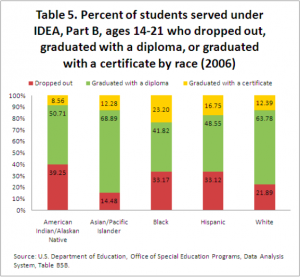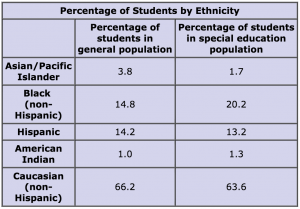“Children with disabilities are often disproportionately and unfairly suspended and expelled from school and educated in classrooms separate from their peers. Children of color with disabilities are overrepresented within the special education population, and the contrast in how frequently they are disciplined is even starker.”
– Former US Secretary of Education John B. King Jr.2
 1
1
Disproportionality in Special Education
Disproportionality in special education refers to the phenomenon that students from certain racial and socioeconomic groups, specifically low income people of color, are disproportionately placed in special education compared when compared with their White peers (Bal et al., 2014). The consequences that students suffer from this misguided and systematic misallocation of special education resources include the stigma of disability, separation from classmates, and an education that may not be at the appropriate level. An additional consequence is that special education resources are taken away from other children who actually need them (Bal et al., 2014).
Additionally, certain groups of students who are placed into special education are more likely to be suspended and drop out of school. The fact that certain races are disproportionately placed in special education adds to racial disparities in drop out and suspension rates.
This figure taken from the US department of education shows the proportion of 14-21 year old students who are served under the Individuals with Disabilities Education Act (IDEA) and their academic achievement by race. 6 It shows that Black, Hispanic and American Indian/Alaskan Native students who are served under IDEA have relatively low rates of graduating with a diploma compared with their White and Asian/Pacific Islander peers.

6
Red = Dropped out
Green = Graduated with a diploma
Yellow = Graduated with a certificate
The figure below shows the percentage of students in the general population and in special education by race in the United States. It shows that certain groups, like Black (non-Hispanic) groups are over represented in special education compared with the general population of Black students.

4
